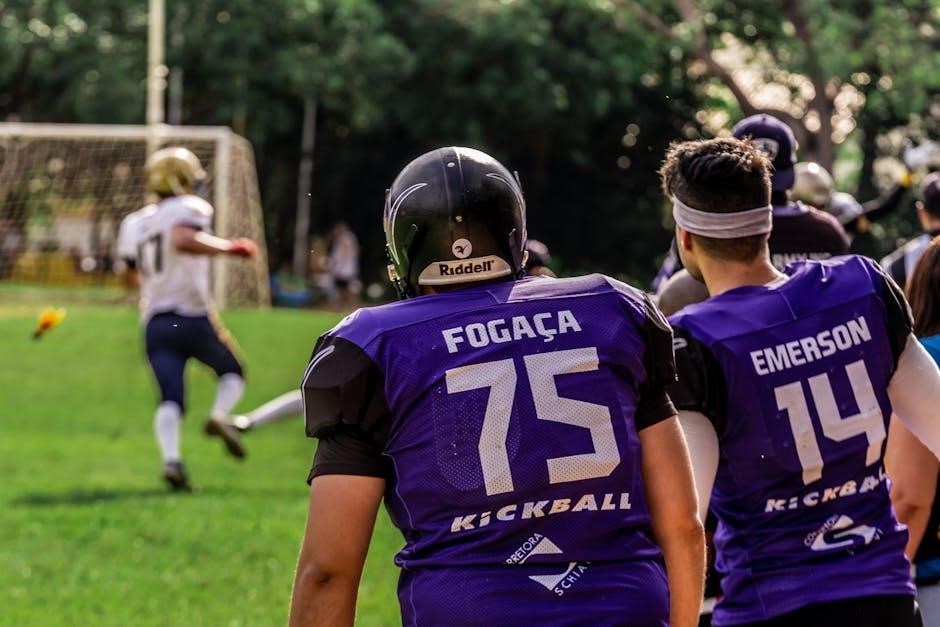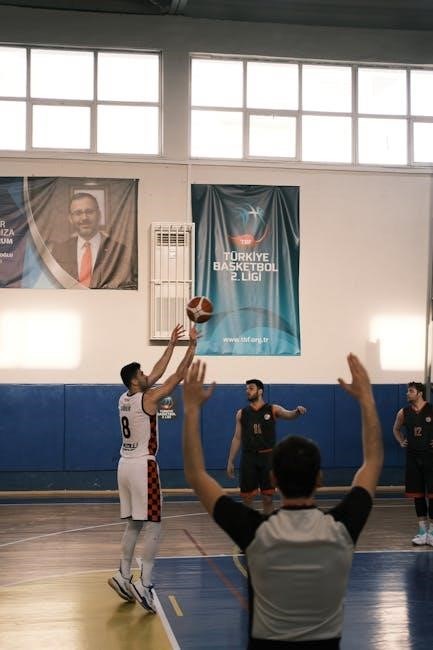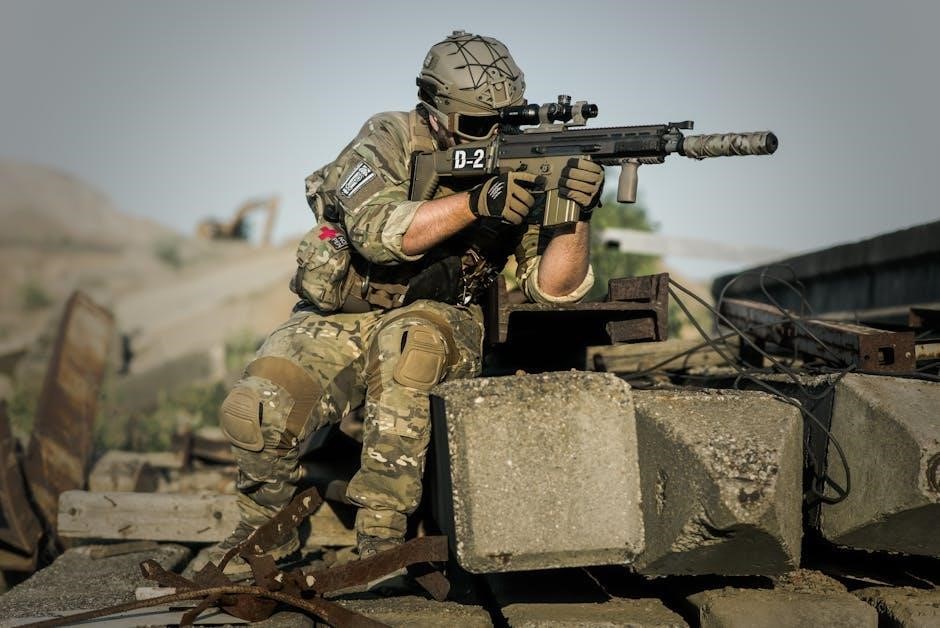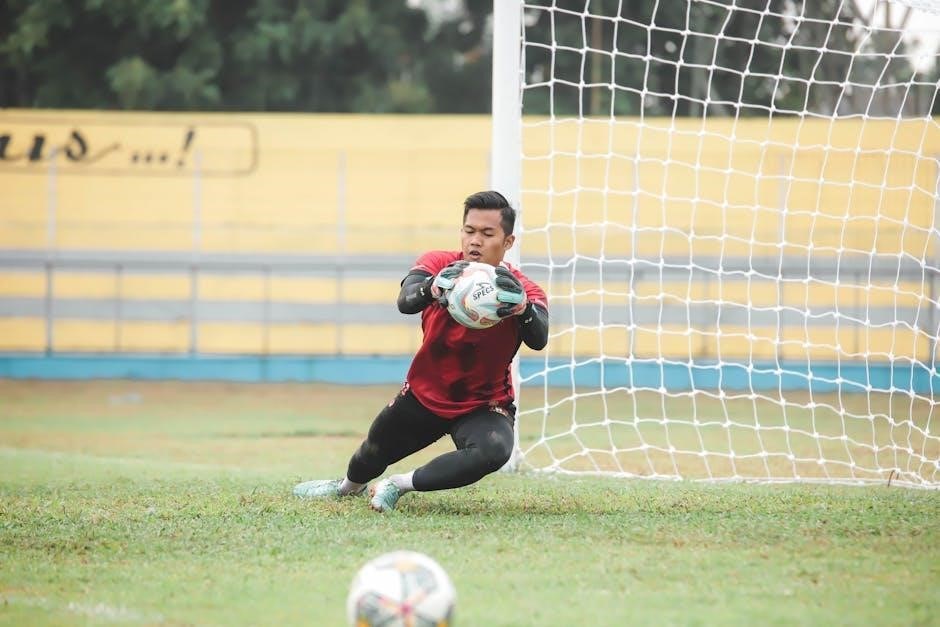Key Components of the 6-2 Defense
The 6-2 defense features six defensive linemen and two linebackers, with three defensive backs. The defensive line focuses on stopping the run, while linebackers are key playmakers. Defensive backs provide coverage support, ensuring balanced defense execution.
Defensive Line
The defensive line in the 6-2 defense consists of six players who line up along the line of scrimmage. Their primary role is to stop the run and occupy blockers, freeing up the linebackers to make plays. The defensive linemen typically align in a 3-point stance and are responsible for controlling the gaps at the line of scrimmage. They use techniques such as gap responsibility and block shedding to maintain discipline and prevent offensive runners from breaking through. The defensive line is also trained to contain the edges, ensuring that plays do not get outside. By focusing on physical play and proper alignment, the defensive line forms the backbone of the 6-2 defense, allowing the linebackers and secondary to operate effectively. Their execution is critical to the defense’s success against run-heavy offenses.
Linebackers
In the 6-2 defense, the two linebackers are the focal points for making plays and orchestrating the defense. They are typically the team’s best athletes, as their responsibilities include calling strength, covering receivers, and supporting the run. Linebackers are often placed in a 3-point stance to allow quick reaction to the snap. Their primary duties include keying the offense, filling gaps, and ensuring nothing gets outside. They must also backpedal on every snap to maintain coverage while being prepared to run support once the ball crosses the line of scrimmage. Proper training and execution are critical, as the linebackers’ performance directly impacts the defense’s effectiveness. Their ability to read the offense and react swiftly is essential for the 6-2 defense to succeed against both run and pass plays.
Defensive Backs
In the 6-2 defense, the three defensive backs play a crucial role in providing secondary support. Their primary responsibilities include man-to-man coverage on eligible receivers, backpedaling on every snap, and avoiding getting beat deep. The corners and safeties must key on receivers and maintain proper alignment based on the strength call made by the linebackers or free safety. Defensive backs are also expected to provide run support once the ball crosses the line of scrimmage, ensuring nothing gets outside. Their ability to contain plays and prevent big gains is vital to the defense’s success. Proper training and execution of their assignments are essential for the 6-2 defense to effectively counter both run and pass-heavy offenses.
Strengths and Weaknesses of the 6-2 Defense
The 6-2 defense excels against run-heavy offenses due to its six defensive linemen, providing a strong presence at the line of scrimmage. It is easy to coach, making it ideal for youth teams, and allows linebackers to focus on making plays. However, its reliance on just two linebackers can leave it vulnerable against pass-heavy offenses. The defense struggles with man-to-man coverage in spread formations, as defensive backs may be stretched thin. Additionally, it requires disciplined execution to avoid overcommitting to the run, leaving gaps in pass defense. While effective in stopping the run, the 6-2 defense can be exploited by teams with strong passing games or advanced offensive strategies.

Playbook Structure
The 6-2 defense playbook is structured to provide clear guidance for coaches and players, focusing on definitions, positions, and alignments. It begins with an overview of the defense, detailing the roles of the six defensive linemen, two linebackers, and three defensive backs. The playbook outlines base alignments, adjustments to various offensive formations (e.g., double tight ends, twins, trips, and quads), and specific calls for defensive linemen and linebackers. For example, defensive line calls include In/In, In/Out, and Out/Out, while linebacker calls emphasize pursuit and gap responsibility. The playbook also addresses pass coverage, with man-to-man and zone strategies. Additional sections cover coaching tips, player techniques, and game situation strategies. This structured approach ensures teams can execute the 6-2 defense effectively, making it a valuable resource for youth and advanced teams alike.
Base Alignments in the 6-2 Defense
The 6-2 defense base alignment positions six defensive linemen along the line of scrimmage, creating a strong presence to counter run-heavy offenses. The linemen are spaced to cover gaps, with defensive ends often in a 3-point stance. The two linebackers, typically the team’s best players, are positioned behind the defensive line, allowing them to flow to the ball and make plays. The three defensive backs align deeper, with corners and safeties providing support. This alignment emphasizes stopping the run by occupying blockers and freeing linebackers. The defense adapts to offensive formations, such as shifting to counter tight ends or motion. Base alignment is the foundation, ensuring all players understand their roles before adjustments. This setup balances strength against the run while maintaining defensive integrity. Effective execution relies on disciplined alignment and quick reactions.

Adjustments in the 6-2 Defense
The 6-2 defense is highly adaptable, with adjustments made to counter various offensive formations. Against double tight ends, the defense may shift its alignment to strengthen the edge. For twins or trips formations, defensive linemen adjust their gaps to account for unbalanced sets. Linebackers and defensive backs communicate to ensure coverage is balanced. The defense uses calls like “In/In,” “In/Out,” and “Out/Out” to shift the defensive line and linebackers. Motion adjustments are critical, with defenders passing off receivers to maintain coverage. The inside linebackers or free safety often make the “strength call,” directing the defense to align properly. This flexibility allows the 6-2 to remain effective against diverse offensive looks while maintaining its core strength against the run. Adjustments are tailored to the offense, ensuring the defense stays one step ahead. Proper execution of these adjustments is key to the defense’s success.

Strategies for the 6-2 Defense
The 6-2 defense employs several strategies to maximize effectiveness. Coaches often emphasize stopping the run by loading the box with six defensive linemen. Linebackers are positioned to make plays at the point of attack, while defensive backs provide deep support. The defense thrives against run-heavy offenses, common in youth football. Strategies include aggressive pursuit, gap discipline, and man coverage on receivers. Play calling focuses on defensive line calls like “In/In” and “Out/Out” to control gaps. Linebackers use calls like “Sam” and “Will” to adjust alignments. Motion adjustments ensure coverage is maintained. Strength calls by the inside linebackers or free safety direct the defense. Coaches stress fundamentals like tackling and block shedding. By aligning correctly and executing assignments, the 6-2 defense can dominate against balanced attacks, making it a popular choice for youth teams. Proper training and execution are critical to its success.

Coaching and Training Tips
Coaching the 6-2 defense requires a focus on simplicity and repetition. Start by teaching defensive linemen to occupy blockers and control gaps. Linebackers must read keys quickly and flow to the ball. Defensive backs should prioritize man coverage and provide run support. Assign roles based on player strengths—use your best tacklers at linebacker. Emphasize pursuit drills to ensure all players rally to the ball. Teach gap discipline to prevent overcommitting. Use tackling drills to improve fundamentals. Practice adjustments for various offensive formations, such as double tight ends or trips. Communicate strength calls clearly to align the defense properly. Keep the playbook simple for youth players and build confidence through repetition. Encourage aggressive play while maintaining assignment discipline. Make practice game-like to prepare for real scenarios. Consistent execution is key to the 6-2 defense’s success.
- Focus on fundamentals.
- Assign roles based on player strengths.
- Prioritize gap discipline and tackling techniques.
- Use repetition to build confidence and consistency.

Execution of the 6-2 Defense
The 6-2 defense relies on six defensive linemen occupying blockers and controlling gaps, while two linebackers flow to the ball and defensive backs provide man coverage and run support.
Base Alignment
In the 6-2 defense, the base alignment features six defensive linemen positioned across the line of scrimmage, typically with four down linemen and two stand-up edge players. The defensive ends align wide to set the edge, while tackles and a nose guard occupy the interior gaps. Linebackers are positioned 3-4 yards deep, inside the defensive linemen, with the inside linebacker often making the strength call to align the defense. Defensive backs include two cornerbacks and one free safety. Corners align 5-7 yards deep outside, covering receivers, while the safety provides deep support. The strong side linebacker may cheat slightly to the offensive strength, and adjustments are made based on offensive formation. This alignment is designed to stop the run and challenge quick passes, with linebackers flowing aggressively to the ball.
Assignments
In the 6-2 defense, each position has clear assignments to ensure effective execution. The defensive linemen are responsible for occupying blockers and controlling specific gaps. The defensive ends set the edge and contain outside runs, while tackles and the nose guard occupy interior gaps to stop inside runs. Linebackers are the playmakers, with the inside linebacker often making the strength call and aligning the defense. They are responsible for filling gaps and pursuing the ball carrier. Defensive backs provide coverage support, with corners covering receivers and the free safety offering deep support. Assignments emphasize stopping the run first, with linebackers flowing aggressively to the ball and defensive backs providing run support when needed. These roles are critical to the defense’s success in controlling the line of scrimmage and limiting offensive production. Proper execution of assignments is essential for the 6-2 defense to thrive.
Techniques
The 6-2 defense relies on specific techniques to execute its assignments effectively. Defensive linemen use gap-control techniques to occupy blockers and maintain their assigned gaps. They employ hand placement and footwork to shed blocks and pursue the ball carrier. Linebackers utilize key-and-flow techniques to read the offense and fill gaps aggressively. They must also master tackling fundamentals to secure stops. Defensive backs focus on man-to-man coverage and zone responsibilities, ensuring receivers are contained and deep support is provided. Proper alignment and communication are critical, as the defense relies on each player executing their role seamlessly. These techniques, when combined, create a formidable defensive unit capable of stopping run-heavy offenses while maintaining coverage discipline. Effective technique execution is vital for the 6-2 defense to achieve its goals. Coaches emphasize repetition and drills to refine these skills.

Game Situations for the 6-2 Defense
The 6-2 defense excels in specific game situations, particularly against run-heavy offenses. It is ideal for stopping the run in short-yardage and goal-line scenarios, where its six defensive linemen can overwhelm the offensive line. The defense is also effective when facing offenses that rely on tight ends or fullbacks, as it can match their physicality. In youth football, where passing is less frequent, the 6-2 defense is a strong choice to control the line of scrimmage. Additionally, it can be used to conserve energy by reducing the need for complex adjustments. Coaches often employ the 6-2 in situations where they anticipate a heavy dose of inside runs or when the offense is in a jumbo formation. Its simplicity and alignment make it a reliable option for teams looking to dominate against the run.

Comparison with Other Defenses
The 6-2 defense is often compared to the 4-4 and 5-3 defenses, as all three are eight-man fronts. Unlike the 4-4, which has four linemen and four linebackers, the 6-2 emphasizes a stronger defensive line presence. This makes it more effective against the run but less flexible in pass coverage. The 5-3 defense, with five linemen and three linebackers, offers a balance between the two, while the 6-2 leans heavily into stopping the run. The 6-2 is particularly advantageous in youth football, where offenses often rely on running plays. Its simplicity and alignment make it easier for younger players to execute, unlike more complex schemes like the 4-4. However, it can struggle against pass-heavy offenses, as it has fewer linebackers to cover receivers. Overall, the 6-2 is a strong choice for teams focused on controlling the line of scrimmage.
The 6-2 defense is a highly effective scheme, particularly for youth football, due to its simplicity and emphasis on stopping the run. By aligning six defensive linemen and two linebackers, it provides a strong presence at the line of scrimmage, making it difficult for offenses to establish a consistent running game. The defensive backs play a crucial role in pass coverage, ensuring the defense remains balanced. The playbook’s detailed adjustments for various offensive formations, such as double tight ends and trips, allow coaches to optimize their strategy. The 6-2 defense is easy to coach, making it ideal for younger players, while its flexibility enables advanced teams to adapt to different game situations. With proper execution, this defense can be a powerful tool for any team, fostering both individual skill development and overall performance.

Additional Resources
Coaches and players can access comprehensive guides and playbooks tailored to the 6-2 defense. PDF resources like the “6-2 Defense Playbook 5th & 6th Grade” offer detailed strategies, base alignments, and adjustments for various offensive formations. Websites such as FootballCoach.net provide additional insights, including the “6-2 Shooter” defense scheme. These materials cover defensive line calls, linebacker assignments, and secondary coverage techniques. For youth football, platforms like FirstDown PlayBook offer customizable play sheets and drills. Coaches can also explore videos and articles on platforms like YouTube and coaching forums for practical tips. These resources ensure teams can master the 6-2 defense, optimize performance, and adapt to game situations effectively. They are invaluable tools for enhancing defensive execution and achieving success on the field.